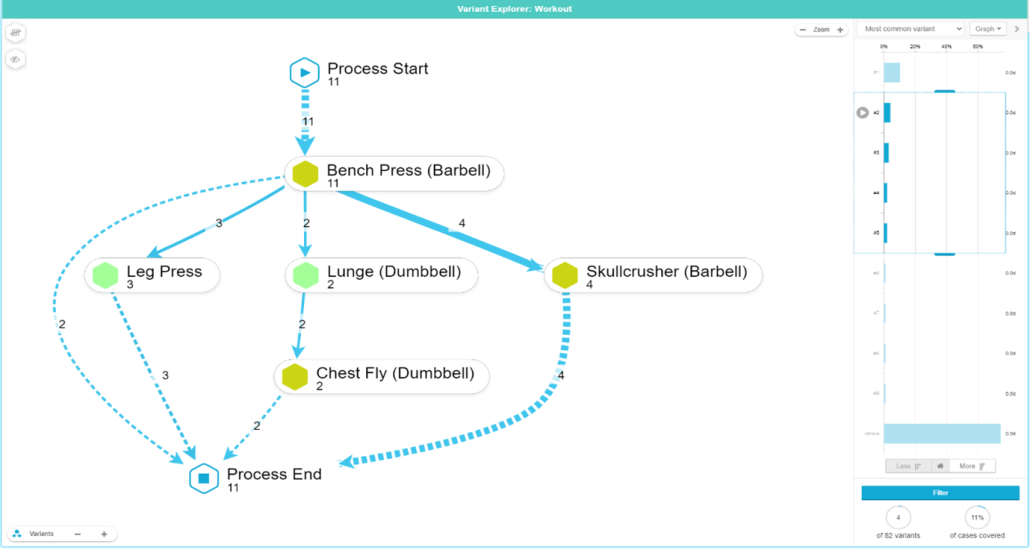Process Mining Analysis — Workouts
To begin with, most of the time, process mining is utilized to improve business processes. However, process mining can have many different use cases. For example, one of the fields that process mining can give value is the workout schedule of a gym enthusiast. Workouts are a collection of exercises that can be easily depicted and applied to process mining. However, where does a gym-goer drive his or her value from process mining? Process mining can help such an individual identify what days of the week the person lifts heavier, what order of exercises is optimal for the person to achieve his or her highest performance, or what exercises are the optimal predecessor to accomplish his or her strongest conduct.

tags
date
05 May 2022To begin with, most of the time, process mining is utilized to improve business processes. However, process mining can have many different use cases. For example, one of the fields that process mining can give value is the workout schedule of a gym enthusiast. Workouts are a collection of exercises that can be easily depicted and applied to process mining. However, where does a gym-goer drive his or her value from process mining? Process mining can help such an individual identify what days of the week the person lifts heavier, what order of exercises is optimal for the person to achieve his or her highest performance, or what exercises are the optimal predecessor to accomplish his or her strongest conduct. In this use case, we analyzed the workout schedule of a gym lover that tracked his exercises from October 2020 until August 2021. In general, the person instead focuses on having fewer heavy weights but has more sets and repetitions per set. Thus his goal is to understand better how his workouts resemble, how he can improve the overall volume of specific exercises and how he can surpass his personal best.
FIRST GLANCE
The figure below depicts a simplified version of the different exercises in a workout. It is vital to point out that this person had 98 workouts throughout collecting the workout data and has 82 different variants. This means that the person had 82 unique exercises in a workout that all had a unique flow of exercises. The different colors pinpoint the primary muscle group the exercise focuses on. For instance, yellow indicates that the exercise focuses on the triceps and chest, while green indicates focusing on the leg and abdominal. This will help the gym-goer to identify what specific muscle groups he or she trains during his or her workouts.
WORKOUT OVERVIEW
One of the other dashboards we created gives some charts and information regarding the overall workout performance. First, the person can identify what days of the week he or she lifts higher weights than the rest of the week. It is quite interesting to point out that the person lifted the most weights on Mondays and had the highest weight per set. Besides, the dashboard points out in which months the person had the most workouts and the highest weight per workout. In this case, July was a high-performing month. On the other hand, the months between January and April relatively enclosed smaller weights due to the closing of gyms in the Netherlands. Lastly, it is pretty interesting to see that the optimal tradeoff for the volume of exercises and heavy lifting lies within having three exercises per workout. This way, the person can optimize his or her number of activities per workout to perform the best — both in terms of strength and velocity. The table in the figure below further depicts workout-specific information.
ACTIVITY OVERVIEW
The Activity Overview depicted exercise-specific information as a collection of sets performed in one workout. That means it would not investigate specific sets but rather the collection of sets in a workout. In the figure below, the dashboard portrays an overview of the exercise “21”, an exercise training the bicep. The first graph illustrates the average total weight per exercise against the volume of a workout. In this case, having four exercises in the workout brings the highest performance. This will help the gym-goer to understand the optimal number of activities for each exercise. Some exercises might be better in combination with higher exercises.
Moreover, the graph “Impact of the Position” shows that when having the exercise as the first activity in a workout, the performance is the strongest compared to executing the exercise as the second or third activity. This can further aid the person in identifying the order of the exercises. Similarly, the last feature can aid the gym enthusiast to identify what activity must precede to perform the strongest for a specific exercise. Overall, this sheet gives the gym lover an understanding of how many exercises, the position of the exercise, and the preceding exercise impact the athlete’s performance. Consequently, the person can optimize his workout flow based on these findings.
EXERCISE OVERVIEW
The last dashboard focused on individual sets of exercises. In the top right corner in the picture below, the personal best of the exercise is illustrated. With this dashboard, the person can see what days of the week the person has performed an exercise the highest for a given set. Moreover, as before, the impact of the position can aid the person in understanding at what position the exercise must be held in a workout to have the strongest performance. Lastly, a detailed overview shows critical information about certain sets, such as the weight and the set number.
CONCLUSION
Overall, this use case pinpoints the endless possibilities that process mining gives. This analysis provided valuable insights such as understanding what day someone performs better, how performance has evolved over time, the optimal number of exercises in a workout, the optimal order of exercises, or what exercises precede other activities. Process Mining enables gym-goers to get full transparency of their workouts and evaluate under what conditions and external factors the person performs the best.






